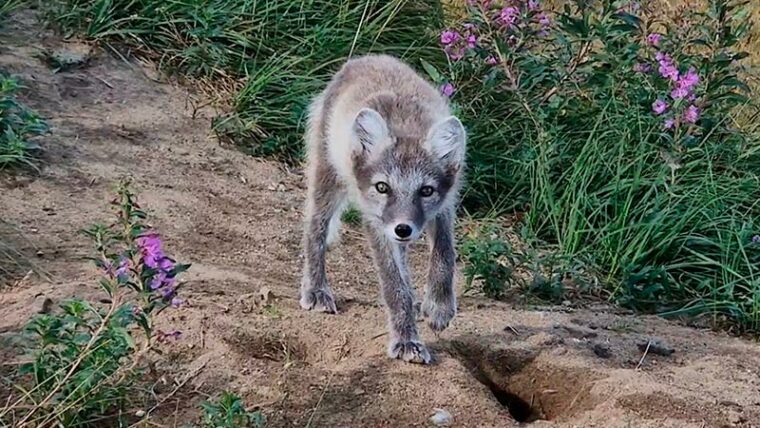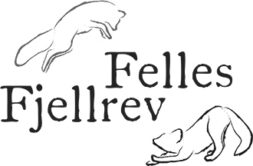Joint press release Metsähallitus and WWF Finland
This summer, three successful Arctic fox dens have been observed in Finland in the Enontekiö fell area. A total of at least nine cubs have been found in three dens. This is the third consecutive summer during which cubs of the extremely endangered Arctic fox have been born in Finland. The return of the Arctic fox to Finnish nature is the result of many years of work.

In 2022, the Arctic fox successfully denned in Finland for the first time in more than 25 years, and last year there were record five dens. In addition to dens, female foxes have also been sighted in different fell areas of Enontekiö and Utsjoki this year.
“We are sure that there was at least one failed Arctic fox attempt to den this summer, when red foxes took over a den where an Arctic fox had cubs last year. Red foxes that have spread to fell areas are the worst competitor of the Arctic fox. Among other things, red foxes takes over denning sites suitable for the Arctic fox,” explains Jukka Ikonen, nature conservation specialist with Metsähallitus Parks & Wildlife Finland. Metsähallitus is responsible for protecting Arctic fox in Finland.
“The number of Arctic fox cubs born this year was lower than last year, as the primary natural source of food for Arctic foxes, voles and lemmings, was low. Together with Metsähallitus Parks & Wildlife Finland, we have been providing extra food to Arctic foxes for several years. Arctic fox feeding machines are particularly important in years with a low vole population,” says Petteri Tolvanen, WWF Programme Director.
In practice, Arctic fox conservation work is:
- providing extra food to Arctic foxes. As an important conservation measure for the Arctic fox, Metsähallitus and WWF maintain feeding stations in the most important areas for the species. Above all, these feeding stations support the survival of juveniles during their first winter and help adult Arctic foxes stay in prime territories, even during years with a low vole population. The feeding machines are built in such a way that red foxes cannot access the food.
- Fox hunting in northern fell areas.
- In Norway, an Arctic fox conservation project has freed natural Arctic foxes born in shelter conditions, releasing them into the wild. In the past few years, the project has also released foxes near the Finnish border. Some of these released Arctic foxes now live in dens on the Finnish side of the border.
- Annual inspections of Arctic fox denning sites. Every year, Metsähallitus Parks & Wildlife, WWF and volunteers inventory previous Arctic fox denning sites in order to find possible denning activity. Hundreds of old denning sites are known in the Finnish fell areas.
- With the support of the Ministry of the Environment, WWF maintains an Arctic fox working group that brings together key parties for Arctic fox conservation.
Higher number of Arctic fox cubs in Sweden and Norway than in Finland
Arctic fox conservation work is carried out in close cooperation with Sweden and Norway. Because the Arctic fox does not know national borders, cross-border cooperation is a vital condition for recovery of the population. According to current data, there are at least 39 Arctic fox dens in Sweden this summer. This data will be confirmed later. The best situation for Arctic fox is in the southern Arjeplogsfjellet fell area of Norrbotten, where the vole population is high this year. There are four Arctic fox dens in the Swedish area adjacent to the Käsivarsi region.
Based on preliminary data, there are 58 Arctic fox dens and some 232 litters in Norway. The best situation is in the southern fell areas, where the vole population has been higher than in the north.
The Nordic Arctic fox population was at its lowest level in the early 2000s, when the population estimate was only 40-60 adult individuals. The combined Arctic fox population in Norway, Sweden and Finland is currently estimated to be approximately 550 adults. Finland sees an estimated 10 to 20 Arctic foxes annually, and the number of observations has been increasing in recent years.
Felles fjellrev – Together for the Arctic fox EU Interreg Aurora project funding safeguards conservation of the Arctic fox in 2024-2026
- With the help of EU funding from Interreg-Aurora, government authorities, universities and nature conservation organisations in Finland, Sweden and Norway will continue and develop long-term Nordic Arctic fox conservation cooperation. Finnish partners include Metsähallitus Parks & Wildlife Finland and WWF Finland.
- The funding will safeguard conservation work for the critically endangered Arctic fox in Finland, Sweden and Norway until the end of 2026.
- The funding received will be used to continue and develop successful Nordic conservation measures, such as providing extra food to Arctic foxes, installing feeding machines in the core Arctic fox areas, hunting red fox in fell areas and releasing Arctic foxes born in shelters. Without active conservation, the Arctic fox is in danger of disappearing from the Fennoscandia region.
With the help of project funding, Metsähallitus continues and develops the extra feeding of Arctic fox, the hunting of red foxes in fell areas in cooperation with local volunteer hunters and reindeer herders, monitoring the Arctic fox population and collecting samples related to the DNA and health of the Arctic fox. WWF will organise an information campaign on the importance of waste management for fishers and hikers. Fish parings and food residues left in the terrain make it easier for the worst competitor of the Arctic fox to survive on the barren fells.
Previously on the topic:
- Press release 21 March 2024 on EU funding for Arctic fox conservation work (in Finnish): Naalin pelastaminen pohjolassa jatkuu: Suomi, Ruotsi ja Norja saivat rahaa työhön EU:lta.
- Watch a video (instagram.com, in Finnish) showing Arctic fox conservation work in practice in April of 2024.
- Press release 19 March 2023 on Arctic fox denning in the summer of 2023 Denning of the critically endangered Arctic fox successful for the second consecutive year: at least 16 Arctic fox cubs were born in Finland in the summer.
Further information:

